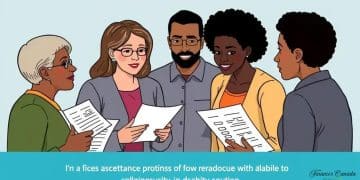Updates to student loan forgiveness programs: what you need to know

Updates to student loan forgiveness programs provide important changes that can help borrowers qualify for debt relief, improve financial stability, and offer new opportunities for financial management.
Updates to student loan forgiveness programs are crucial for many borrowers navigating their financial futures. With new changes rolling out, understanding your options can significantly ease the repayment burden. Ready to dive into what these updates mean for you?
Overview of student loan forgiveness programs
Understanding the overview of student loan forgiveness programs can help borrowers navigate their financial options better. These programs are designed to alleviate the burden of student debt for qualified individuals.
Many borrowers may qualify based on their occupation, income level, or repayment plan. It is essential to know that not all loans are eligible for forgiveness, and each program has specific requirements.
Types of Student Loan Forgiveness Programs
There are several types of forgiveness programs available to borrowers. Here are the main ones to consider:
- Public Service Loan Forgiveness (PSLF): Available to borrowers working in qualified public service jobs. After making 120 qualifying payments, borrowers may have their loans forgiven.
- Teacher Loan Forgiveness: Specifically for teachers who work in low-income schools. They may qualify for forgiveness up to $17,500.
- Income-Driven Repayment (IDR) Forgiveness: Borrowers enrolled in income-driven plans may qualify for forgiveness after 20 or 25 years of qualifying payments.
Each of these programs offers unique benefits and eligibility requirements that borrowers should carefully review. For instance, if you work for a non-profit organization, the Public Service Loan Forgiveness program could significantly reduce your debt.
It’s vital for borrowers to stay informed about the changes and updates to these programs. Government policies can shift, and new opportunities may arise. Therefore, regularly checking official resources can ensure borrowers are aware of their options.
In conclusion, understanding the overview of student loan forgiveness programs is key to making informed financial decisions. With the right knowledge, borrowers can pursue the best options available to them.
Recent changes in federal policies

Staying informed about the recent changes in federal policies regarding student loan forgiveness is essential for borrowers. These modifications can significantly impact your financial situation and eligibility.
In the past year, there have been several key updates to existing programs. For instance, the eligibility criteria for some forgiveness programs have been broadened. This means more borrowers may qualify than before.
Notable Policy Changes
Some important changes include:
- Expanded Eligibility: More borrowers can now qualify for Public Service Loan Forgiveness if they meet new criteria.
- Temporary Waivers: The government has introduced temporary waivers that simplify the application process, making it easier for borrowers to seek forgiveness.
- Income-Driven Repayment Updates: Changes have been made to repayment plans that can lead to quicker forgiveness for eligible borrowers.
Furthermore, awareness about these changes is crucial. Many borrowers are unaware that certain actions can affect their eligibility for loan forgiveness. Keeping track of deadlines and necessary paperwork is vital for maintaining eligibility.
Overall, understanding these recent federal policy changes can empower borrowers to take control of their financial futures. As updates continue to roll out, staying educated will help individuals navigate their options effectively.
Eligibility criteria for the latest programs
Understanding the eligibility criteria for the latest programs in student loan forgiveness is essential for borrowers looking to reduce their debt. Each program has unique requirements, and staying informed can significantly enhance your chances of qualification.
Typically, eligibility is determined by factors such as your job, income level, and the type of loans you hold. Many borrowers may feel overwhelmed by the options, but knowing what to look for can make a big difference.
Common Eligibility Requirements
Some of the most common eligibility criteria include:
- Employment Status: You’ll need to work in a qualifying public service job or a non-profit organization.
- Loan Type: Only certain federal loans are eligible for forgiveness, so it’s critical to verify the type of loans you have.
- Payment History: Many programs require borrowers to have made a specific number of qualifying payments, often needing documentation to support this.
In addition, income-driven repayment plans may have unique eligibility criteria related to your income and family size. Keeping your information up to date is crucial for maintaining your eligibility for these programs.
Understanding the eligibility criteria for the latest programs allows borrowers to assess their qualifications more effectively. Those who track the necessary qualifications and stay organized can successfully navigate these opportunities for loan forgiveness.
Application process for student loan forgiveness

The application process for student loan forgiveness can seem complicated, but knowing the steps can make it easier. Understanding what is required will help you submit a successful application.
Generally, the application process consists of several key steps. Start by gathering all the necessary documentation. This may include loan information, employment verification, and any relevant financial records.
Steps in the Application Process
Here are the main steps you should follow:
- Check Eligibility: Before applying, confirm that you meet the eligibility requirements for the forgiveness program you want to apply to.
- Fill Out the Application: Complete the application form accurately. Make sure to provide all required information, as missing details can delay the process.
- Submit Documentation: Along with your application, you’ll need to submit supporting documents. This is critical for verifying your eligibility.
- Follow Up: After you’ve submitted your application, stay in contact with your loan servicer. Checking in can help ensure that your application is processed smoothly.
Each forgiveness program may have specific requirements, so it’s essential to read the guidelines carefully. Additionally, some programs might have different forms or formats for applications. Be prepared to provide not only personal and loan information but also proof of employment and any other necessary documentation.
By understanding the application process for student loan forgiveness, you can take proactive steps to lessen your debt. Each effort you make will bring you closer to financial relief.
Impact of student loan forgiveness on borrowers
The impact of student loan forgiveness on borrowers is profound and can change lives. Many individuals feel overwhelmed by their debt, and forgiveness programs can provide a path to financial relief.
When borrowers qualify for forgiveness, they can experience significant changes in their financial situation. For some, it means the end of monthly payments, allowing them to redirect that money towards savings or other obligations.
Positive Outcomes
The benefits of student loan forgiveness include:
- Increased Financial Freedom: With reduced debt, borrowers can enjoy greater financial stability and the freedom to make choices that they may not have been able to before.
- Improved Credit Score: Eliminating student loans can lead to a better credit score, which helps in securing loans for homes or cars.
- More Opportunities: Freed from student debt, borrowers can pursue further education, invest in their careers, or even start businesses.
However, it’s also essential to consider potential downsides. Some borrowers may worry about the implications of having their loans forgiven. This includes impacts on their tax situation, as some types of forgiveness may count as taxable income. Additionally, feelings of uncertainty about future eligibility for forgiveness can cause stress.
Overall, understanding the impact of student loan forgiveness on borrowers provides a clearer picture of what it means for individuals seeking financial relief. While the benefits often outweigh the potential drawbacks, each borrower’s situation is unique.
In conclusion, understanding student loan forgiveness programs is crucial for borrowers who want to lessen their debt burden. By exploring the recent updates, knowing the eligibility criteria, and carefully navigating the application process, individuals can significantly impact their financial futures. The benefits of forgiveness can offer a path to increased financial freedom, improved credit scores, and new opportunities. However, it’s essential to remain informed about potential implications and stay proactive in managing your loans. Take the time to research and utilize the available resources to get the most out of student loan forgiveness programs.
FAQ – Frequently Asked Questions about Student Loan Forgiveness
What is student loan forgiveness?
Student loan forgiveness is a program that allows borrowers to have some or all of their loan debt canceled under specific conditions.
Who is eligible for student loan forgiveness?
Eligibility usually depends on factors like your job, income level, and the type of loans you have.
How do I apply for student loan forgiveness?
To apply, gather necessary documentation, fill out the application, and submit it to your loan servicer along with any required supporting documents.
Can student loan forgiveness affect my taxes?
Yes, in some cases, the amount forgiven may be considered taxable income, so it’s crucial to consult a tax professional for guidance.





